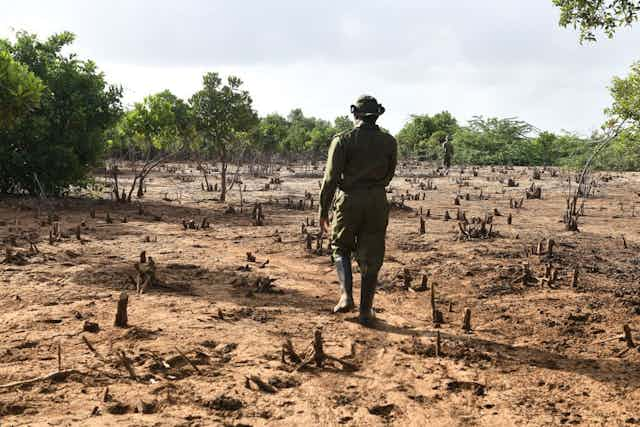Kenyan president William Ruto has lifted a six-year ban on logging, despite public objections. Ruto said it would create jobs and boost economic growth. Lisa E. Fuchs has studied the Mau Forest Complex, one of Kenya’s most important – and most threatened – forests. She unpacks the implications of this decision.
Why is the lifting of Kenya’s logging ban controversial?
A logging ban is a political instrument. Its effectiveness depends mainly on two things. First, who is included and who is not, and why and how these actors will be supported to re-orient themselves sustainably. Second, the political will to implement it according to its intention.
The same applies for lifting a logging ban. But it’s important to keep in mind that controversial political announcements and decisions target different audiences.
Kenya’s latest logging ban was introduced in 2018. This government directive was informed by shrinking water resources and came amid discussions to save Kenya’s water towers.
Deforestation in Kenya rose steeply from the early 1990s. According to estimates from the United Nations Environment Programme, the deforestation rate in Kenya was 5,000 hectares per year by 2010. This had several effects, including changes in biodiversity, river flows and the microclimate. They had an impact on agricultural production, hydropower generation and inland fish production. Human health and well-being were also affected.
Environmentalists have argued that lifting this latest ban risks reversing the gains made in recent years to improve Kenya’s tree cover. The country surpassed its 10% minimum tree cover target in June 2022. It now plans to raise tree cover to 30% by 2032 by planting 15 billion trees.
Trees and forests provide ecosystem services like air, climate and water regulation. These influence landscapes, livelihoods, economies and entire food systems.
Read more: How politics has subverted conservation efforts to protect Kenya’s Mau Forest
I have studied Kenya’s failure to “Save the Mau”. This was the tagline of a large-scale campaign to rehabilitate the Mau Forest Complex in 2009. It involved multiple stakeholders, led by government and supported by civil society.
The Kenyan state has historically viewed and dealt with forests in terms of production and economic development, rather than biodiversity and conservation. Ruto, as minister for agriculture (2008-2010) and as deputy president (2013-2022), has repeatedly defended this stance.
How have previous logging bans in Kenya played out?
A similar ban – or rather, a three-month moratorium that was never officially lifted – existed between 1999 and 2011. In 1999, the country’s forests were in a bleak state. “Post box sawmillers” – companies that existed on paper but not in practice – were held responsible for much of the disaster, alongside the Forestry Department, which was in charge of registering and licensing them.
The moratorium nullified these sawmillers’ licences. It restricted them from legal logging, denying them access to public forests. What many people don’t know is that this ban was only partial. Kenya’s big timber producing companies (Timsales, Raiply, Comply and, intermittently, Pan-African Paper Mills) continued harvesting, processing and selling wood, timber and non-timber forest products without restriction.
These politically well-connected companies held a monopoly over the production and export of wood products.
In 1999, forest management was still regulated by the 1960 Forest Act. This law was widely held responsible for legal forest destruction by allowing the minister for forestry to convert the legal status of public forest land through a simple order published in the government Gazette.
However, even after the adoption of the landmark 2005 Forests Act and the formation of the Kenya Forest Service in 2007, the situation didn’t change as much as it should have. Existing regulations were poorly applied.
Corruption played a part in forest destruction by both big timber companies and small-scale saw millers. The Kenya Forest Service has repeatedly been named in this context in both academic and public inquiries, including a 2018 investigation.
What is the current political context?
The political climate in Kenya is heated.
Ruto has been under tremendous pressure since he took office in September 2022. The opposition has mobilised public protests over the cost of living. Sending a message about creating jobs can be read as an attempt to address people’s worries related to the economy.
At the same time, discussing forests can be interpreted as directly engaging opposition leader Raila Odinga, who led the “Save the Mau” campaign until its abrupt halt in 2010-11. Ruto and his allies played an important role in the halt.
During Kenya’s 2022 electoral campaign, Ruto promised change and economic empowerment through a bottom-up development model. Redistributing access to and benefits from the country’s forests might speak to many rural people and communities who are dependent on forest commodities – and to their political representatives. And having inherited a deeply indebted economy, Ruto has been looking for new avenues to generate revenue.
What’s the way forward?
Depoliticising environmental and forest conservation will help in seeking sustainable solutions. It will be particularly important to address the speculation over the lifting of the logging ban. The environment ministry recently said the ban had been lifted only in commercial forests.
During my research in the Eastern Mau Forest, it became evident that political changes – or even the fear of political changes which could result in a redistribution of access and user rights – led to what local residents described as a “cutting craze”.
Timber companies, small- and medium-sized sawmills, and even ordinary community members all took extremely short-term approaches to securing benefits from the forest and its resources.
Short-term vision has harmed the country and the environment in Kenya and globally.
Sustainable forest management (which includes both forest production and forest conservation) is not impossible or awfully complicated – at least when it’s not politicised. It mainly requires real political will.

